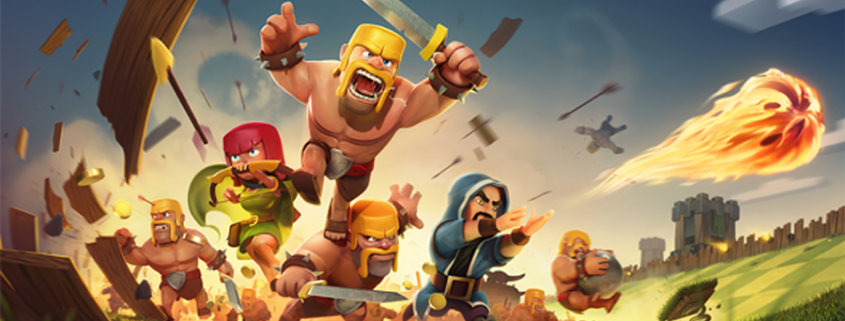The Secret To How Clash Of Clans Makes $2.4 Million Per Day
Powered by Supercell, Finland based app developers (creators of Hay Day – another super-successful mobile game app), earlier in the year announced their confirmation of $130m of secondary funding, at an evaluation of $770m.
What’s amazing is that this ‘Startup’ company only has two games and both are only available on iOS (iPhone, iPad, iPod Touch), which limits them to less than 13.2% smartphone market share.
But that doesn’t seem to be stopping SuperCell from making good coin from their supposed ‘One-Hit-Wonders’. Especially in a struggling market (pointing at the hard times hit by giant game developers EA and Zynga)
Clash of Clans and Hay Day both fall into the ‘Social Game’ category. In Clash of Clans the objective of the game is to build a village (theme set in historic times), attack other villages (other players) and protect your own village from raids. Hence, Clash of Clans…
So what makes a game like Clash of Clans so damn special? And why have they been able to pull off what other game development companies can’t?
Here’s where we start digging:
Let’s first look at the Clash Of Clans gameplay
Honestly, the gameplay used in Clash of Clans is not that unique.
It’s the same old gameplay as seen in many other games.
So you start looking in other areas, but what’s important to first note is that they’re using a social-game-framework (Galaxy Life) that’s been proven to work in the past.
The only thing that is truly unique is the level of “Social Interaction” which forms part of their mobile strategy.
Hay Day was built to allow players to interact by visiting each others farms and trade goods between friends.
Clash of Clans was also built to be social. Players can raid other players’ villages and fight for rankings on a global scoreboard.
…A unique experience
What I like about Clash of Clans, and what I think a lot of people can relate with is their theme.
‘Barbarians, Magicians, Goblins’ – what’s not to like?
Here’s a theme that’s proven successful in the past in games like Skyrim, Diablo, Baldurs Gate… the list goes on…
The lesson here is to observe what’s worked in the past. Ok, so you may have a cool idea for an ‘Attack of the Mice’ game, but here’s the thing…maybe people don’t care for mice?
The other end of that stick is the level of detail in the graphics. This is what the SuperCell employees refer to as “the Soul of the game”.
We often hear the saying “It’s all about the 1%ers.” And it’s true. Ask a real game fanatic to tell you what they like about a particular game. They generally won’t tell you that it’s “the overall concept”, or “the unique gameplay.”
It’s the things like “a captivating story…” or “the little hidden objectives…” that get highlighted.
Keep this in mind when you’re developing your own mobile game.
You gotta get heavy on the marketing
No kidding…
Unfortunately a big deal of a game’s success comes down to marketing.
Sure, you can launch a game on a shoestring budget, but you had better hope that the game is good enough to encourage players to tell their friends all about it.
Bad, average and good games get no credit.
But addictive, remarkable and interesting games quickly become the talk of the town.
The Secret Sauce is in the Culture/Team
The founders of Clash of Clans were no nOObs.
4 of the 6 founders came from Digital Chocolate, a large gaming development company with over 200 employees.
So it’s easy to say that they had experience under their belts, with a few previous successes in social game development.
Another remarkable feature about the SuperCell team is that they run with a Culture of Autonomy.
Each team is considered a cell, and each cell is autonomous in its own right.
They each pick what games they want to work on, and even within the cells the individuals have a level of autonomy.
Of course each cell have a team leader that directs and upholds a certain air of accountability to hit targets, etc. SuperCell CEO Ilkka Paananen’s goal is to become the world’s least powerful CEO by relinquishing control to the “cells”.
“Get the best people then get out of the way and let those people do their jobs,” Paananen said.
Another core to the success of the company comes down to their focus on ‘Fun’. It’s not about the money, which I personally think is a beautiful thing.
No shortage of funding
Lastly, it goes without saying that SuperCell had no shortage of funding.
They didn’t bootstrap their production.
In fact, a year went by before they made a single cent because they were busy putting everything they had into Clash of Clans and Hay Day, which were released consecutively in February and March of 2013.
There’s a lot we can take away from the success of Clash of Clans. And I bet now you’ll keep a closer eye on their movements.
Want more? Read our crash course on how to use gamification to build engaging apps.
Latest posts by Logan Merrick (see all)
- Ep 18: Collective Campus’ CEO on Intrapreneurship and Corporate Innovation - December 20, 2016
- 50 User Engagement Strategies For Planning Memorable Mobile Experiences - December 19, 2016
- Latest Data: App Monetisation Trends And Drivers 2015-2020 - November 25, 2016



